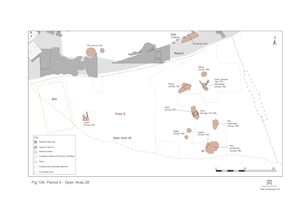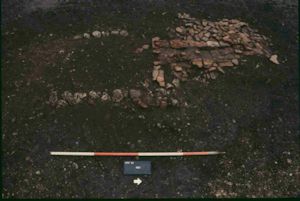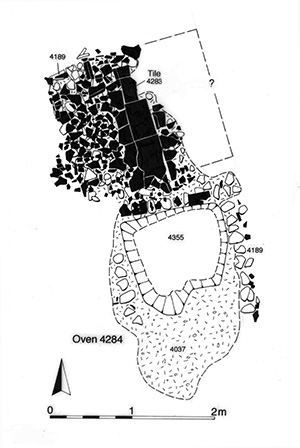
Building 39, continues to occupy the western part of OA28 into Period 4, but would appear to pass out of use in the earlier 3rd century, judging by the overlying deposits interpreted as debris within/over its remains. There is no evidence for its immediate replacement within the investigated parts of the enclosure interior (Figure 154). It is possible that the processing activity represented by adjacent oven/dryers is contemporary with the later life of Building 39.
The survival of subdividing fenceline Structure 27 is not established, but it seems reasonable to assume it remains until the demise of Building 39 alongside. Possible well 4536 (Group 730 Period 3) passes out of use prior to or early in Period 4, but probably receives infill material in the later 2nd century.

It seems likely that Building 39 does not survive much beyond the early 3rd century AD, judging by the latest material in what appears to be a disuse accumulation (4706) over its remains (NB: treated/recorded in the field as a cleaning layer). Certainly, there is no evidence for encroachment upon it by pits or other features of this or earlier date.

In the western part of OA28, a tile-built oven or drying floor (Figures 139 and 171) is constructed over an extensive complex of (unexcavated) inter-cut pits. The northern part of its shallow, roughly rectilinear construction cut 4284 is lined with a 'foundation' course of unworked stone rubble 4189, which extends south to consolidate the top edge of the stoke-hole 4355. A tile-lined flue or duct 4005, laid on a clay bed 4037, baked through heating the structure, is built on the east side of this foundation. The flue survives to a length of 1.8m and depth of 0.12m. The rest of the squared foundation is packed and levelled with silt layer 4188, on top of which is laid a deposit of tile 4283. Three tile courses survive, perhaps building up a platform adjacent to the flue, although it is possible that the flue is centrally located and that a further eastern extent had been lost. The tile-lined flue opens out into square stoke-hole 4355 to its south. The stoke-hole, as mentioned above, is defined on three sides by a line of stone rubble. It appears that the stoke-hole is kept clean, its fill 4024 (Group 734) being post-use infill containing unrelated rubbish.

The structure thus comprises a square platform of stone and tile to the north with an interconnecting stone-lined stoke-hole to the south. No traces of the superstructure survive, the whole of the structure clearly being very disturbed, as denoted by the mass of tile fragments (c. 57kg) collected from overlying cleaning layer 4006 (Group 735). Clues about the function of this structure are extremely sparse, with little charcoal or other burnt debris in evidence and infill deposits looking domestic in character.
Pottery collected from the structure itself is of mid- to late 2nd century AD, which would seem to reflect the approximate date of construction and use of the oven/drying floor. The infill of the stoke-hole/'ash-pit', and therefore the disuse of the whole structure, is dated to the early 3rd century. The coin (SF250) of Claudius II, from cleaning layer 4006, is considered to be intrusive.
A further drying floor structure 4003 (Group 736) lies c. 10m to the north-east of oven/dryer 4005. This survives as a heavily disturbed L-shaped arrangement of broken tile and burnt clay with no recognisable construction cut. At the northern edge of this spread, thin parallel deposits of burnt clay (4610) define the position of a likely flue aligned roughly north-to-south, of which only a 1.1m length survives. Immediately to its south-west is another spread of tile and sporadic burnt patches 4611 (Group 737) on the top of the silt deposit that underlies this structure. Patches of dislodged mortar bonding (4803) are also evident. Shallow stake-holes 4804, 4834, 4836 and 4838) are located beneath spread 4611 and may well be associated with the construction of this structure, all being filled with burnt clayey silt. Small slot 4846 runs parallel to the flue and is also filled with burnt clay. This may be a trace of a further element of the superstructure.
The tile within 4003 seems to be in an already broken state when incorporated into the structure and, together with the scorched silt patches, defines what may have originally been a squared 'platform' alongside the flue. Though fragmentary, the remains suggest a function as a drying floor, rather than a structure such as a kiln in which intense heat is generated. However, the occurrence of small amounts of slag and mould fragments (SF8517) in burnt layer 4909 may alternatively suggest a metalworking function. It is notable that frequent finds of slags and copper-alloy fragments/waste are recovered from many deposits in the vicinity and some will almost certainly be residual from Period 2 and 3 activity.
Adjacent curving gully 25139 (segs 4868, 14033, Group 738) may mark the position of a windbreak around the south-west of the drying floor.
Other activity in OA28 is principally confined to pitting (4016, 4022, 4083, 4102, 4241, 4426, 4487, 4943, 4956, 4961, 14013, 14124). Apart from two slightly doubtful examples, pits are concentrated within the eastern part of the enclosure. Pits are sparser than in Period 3, even if the possibility that some of the latest Period 3 pits were in use into Period 4 is taken into account. It is certainly evident that there is a close continuity in pitting activity between the two periods, with the pattern of 'concentric' (re-cut) pits being continued by pit-pairs [4426/4487] and [4016/4102]. Pits such as 4010 (Group 756, Period 3) and 4083 (Group 739) may indicate the continued, or perhaps renewed, use of the same feature for rubbish disposal. There is, however, a contrast between Periods 3 and 4 in the spatial distribution of the pits - the Period 3 pits clustered to the south, but the most marked cluster of Period 4 pits lies 20m further north.
In terms of content, it is noticeable that metal items are now more likely to be iron than copper alloy, while metalworking debris is absent. Small quantities of vessel glass, opus signinum and tesserae often feature. As in Period 3, pottery and tile are present in quantity but the incidence of animal bone appears increased.
Pit 4943 is typical and contains a very high finds density, including c. 30kg of animal bone (and a single human baby bone) along with a metalwork assemblage that includes three iron blades, a punch, stylus, and a number of other unidentified iron and copper fragments.
Pit 4102 is somewhat similar in its artefact assemblage and is notable for the presence of iron lift key (SF700), stylus (SF337), twenty-eight nails and a copper-alloy coin (SF401). Pit 4487 contains an iron spearhead (SF1187).
Possibly associated with the high animal bone content of these pits is the conspicuous incidence of bone artefacts such as the weaving tool (SF5702) from pit 4943, needle (SF6836) and cut horn (SF7396) from 4083, and hairpin (SF385) from 4016. Although these are all domestic items, this cluster could suggest that bone working may be being carried-out nearby.
A series of dumped layers (4013, 4014, 4084, 4294, 4701) across the southern part of the enclosure perhaps represents an alternative form of waste disposal. These layers seal some of the mid-Roman pits (Group 739) and may constitute the bases or spread remains of midden mounds of accumulated rubbish.
Internet Archaeology is an open access journal based in the Department of Archaeology, University of York. Except where otherwise noted, content from this work may be used under the terms of the Creative Commons Attribution 3.0 (CC BY) Unported licence, which permits unrestricted use, distribution, and reproduction in any medium, provided that attribution to the author(s), the title of the work, the Internet Archaeology journal and the relevant URL/DOI are given.
Terms and Conditions | Legal Statements | Privacy Policy | Cookies Policy | Citing Internet Archaeology
Internet Archaeology content is preserved for the long term with the Archaeology Data Service. Help sustain and support open access publication by donating to our Open Access Archaeology Fund.